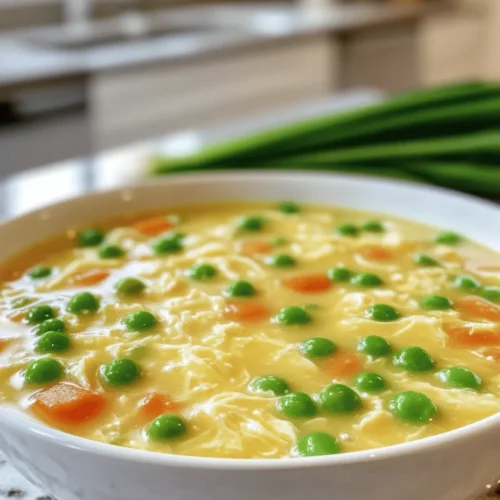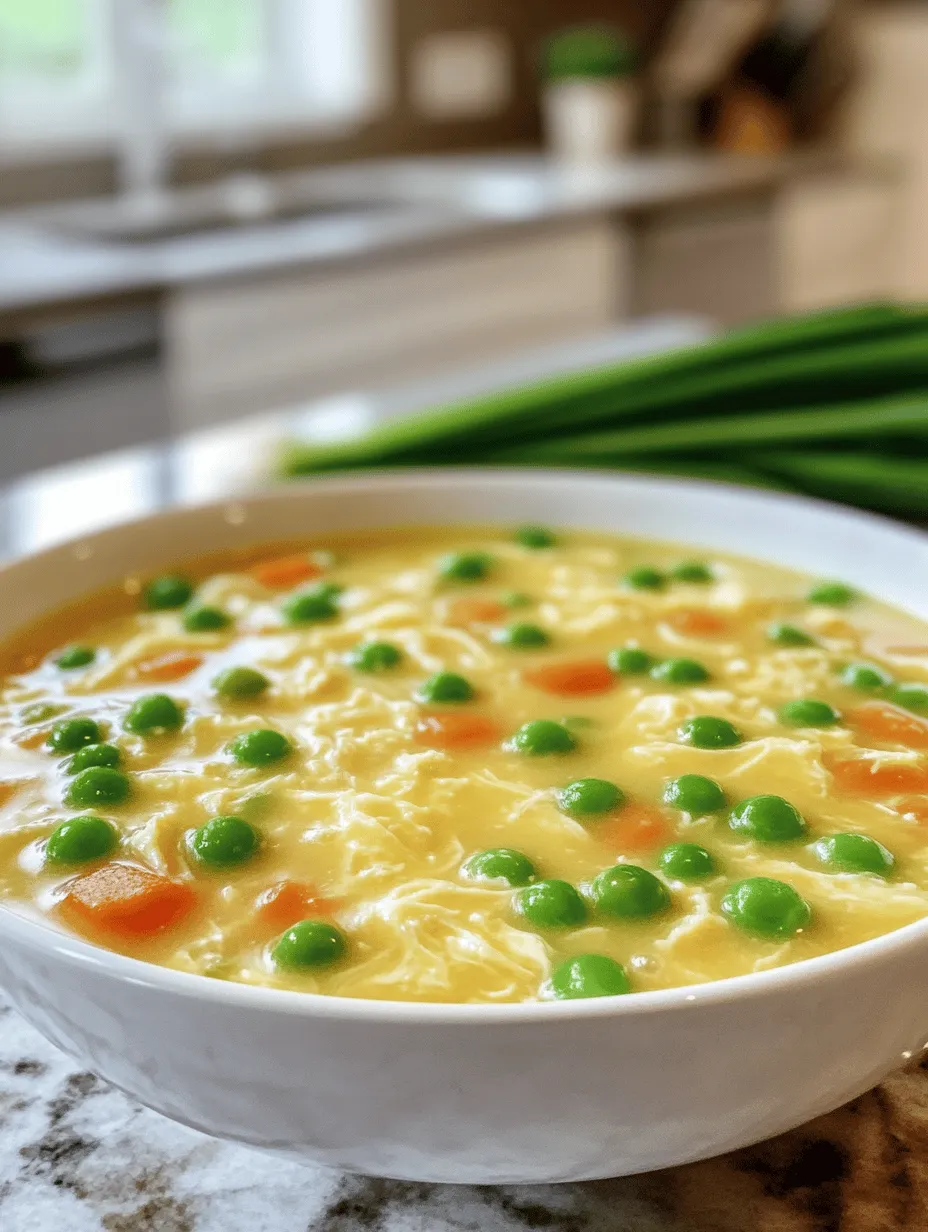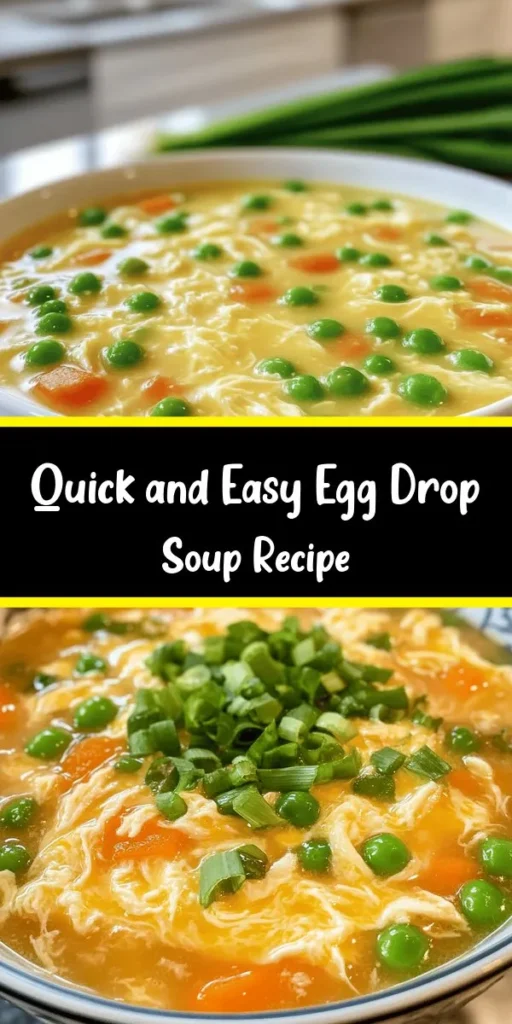Introduction
Welcome to the world of the Simple & Savory Easy Egg Drop Soup, a comforting dish that effortlessly brings warmth and nourishment to your dining table. This delightful soup is not only quick and easy to prepare but also serves as a soothing remedy during chilly evenings or when you’re feeling under the weather. With its light yet flavorful broth, tender vegetables, and silky egg ribbons, it is no wonder this soup has become a staple in many households across the globe.
Egg Drop Soup, known as “” (dàn huā tāng) in Mandarin, is a traditional dish in Chinese cuisine. It is cherished not only for its taste but also for its simplicity and versatility. This soup can be whipped up in minutes, making it an ideal option for busy weeknights or as a comforting bowl of goodness to enjoy on a rainy day. In the following sections, we will delve into the origins of this classic dish, explore its key ingredients and their roles, and guide you through easy step-by-step instructions to recreate this beloved recipe at home.
Understanding Egg Drop Soup
Exploring the Origins of Egg Drop Soup
Egg Drop Soup has a rich history that dates back centuries in China. It is believed to have originated during the Tang Dynasty (618-907 AD), where it was served in royal courts. Over the years, this dish has evolved, gaining popularity among the common folk due to its simplicity and affordability. Traditionally, Egg Drop Soup is made by whisking eggs into a simmering broth, resulting in delicate ribbons that float gracefully throughout the soup.
Culturally significant, Egg Drop Soup represents not only nourishment but also comfort and home. It is often enjoyed during family gatherings and festive occasions, symbolizing warmth and togetherness. As Chinese cuisine spread across the globe, various adaptations of Egg Drop Soup emerged, incorporating local ingredients and flavors. Today, you can find this dish in restaurants worldwide, each with a unique twist that reflects the region’s culinary influences.
Key Ingredients and Their Roles
Understanding the key ingredients in Egg Drop Soup is essential for achieving the perfect balance of flavors and textures. Below is an overview of the primary components that come together to create this delightful dish.
1. Chicken Broth: The Flavor Foundation
– Chicken broth serves as the base of Egg Drop Soup, providing depth and richness to the dish. For a healthier option, low-sodium chicken broth is recommended. This not only enhances the flavor but also reduces the overall sodium content, making it a heart-friendly choice. If you’re vegetarian or vegan, vegetable broth can also serve as a suitable alternative without compromising on taste.
2. Eggs: The Magic of Eggs
– The eggs are the star of the show in Egg Drop Soup, contributing to its signature texture. When whisked into the hot broth, the eggs create delicate ribbons that add a velvety consistency to the soup. Eggs are not only a great source of protein but also packed with essential nutrients such as vitamins A, D, and B12. To achieve the perfect egg ribbons, it’s important to whisk the eggs well and pour them slowly into the simmering broth while stirring gently.
3. Vegetable Medley: Peas and Carrots
– A colorful vegetable medley, typically consisting of peas and carrots, adds nutritional value and visual appeal to the soup. These vegetables are rich in vitamins, minerals, and fiber, making the dish more wholesome. Both frozen and fresh options work well; however, frozen vegetables can save time and are often just as nutritious as fresh ones.
4. Flavor Enhancers: Ginger, Soy Sauce, and Sesame Oil
– To elevate the taste of your Egg Drop Soup, flavor enhancers such as ginger, soy sauce, and sesame oil are essential. Fresh ginger imparts a warm, spicy note, while soy sauce adds umami depth. A drizzle of sesame oil at the end of cooking provides a nutty aroma that rounds out the flavors. For those with dietary restrictions, low-sodium soy sauce or gluten-free alternatives can be used without sacrificing taste.
Ingredients Breakdown
Let’s take a closer look at the specific ingredients you’ll need to make the Simple & Savory Easy Egg Drop Soup, along with their benefits and roles in the dish.
Chicken Broth: The Flavor Foundation
Using chicken broth as the base creates a rich, flavorful foundation for your soup. Opting for low-sodium varieties allows you to control the salt content and lets the other flavors shine through. If you have dietary preferences such as vegetarian or vegan, consider using vegetable broth or mushroom broth, which can add a unique depth of flavor while keeping the dish plant-based.
The Magic of Eggs
Eggs are a powerhouse ingredient in Egg Drop Soup. Not only do they provide essential protein, but they also contribute to the creamy texture that makes this soup so comforting. To ensure that the eggs form beautiful ribbons rather than clumps, whisk them thoroughly before incorporating them into the broth. The key is to drizzle the eggs slowly into the hot soup while stirring gently, allowing them to cook evenly and create that signature silky texture.
Vegetable Medley: Peas and Carrots
Adding peas and carrots not only enhances the visual appeal of the soup but also boosts its nutritional profile. These vegetables are rich in vitamins A and C and provide fiber that aids digestion. You can use fresh vegetables if they are in season, or opt for frozen ones for convenience. Frozen vegetables are often harvested at their peak and flash-frozen, preserving their nutrients effectively.
Flavor Enhancers: Ginger, Soy Sauce, and Sesame Oil
The addition of ginger, soy sauce, and sesame oil brings the soup to life with vibrant flavors. Fresh ginger adds a bit of heat and warmth, while soy sauce introduces a savory umami quality. The final touch of sesame oil enriches the soup with a nutty aroma. For those who need to avoid soy, coconut aminos or tamari can serve as excellent substitutes.
Step-by-Step Instructions
Now that we have a good understanding of the ingredients, let’s dive into the step-by-step process of making Easy Egg Drop Soup. This guide will ensure you create a flavorful and satisfying dish that your family will love.
Bringing the Broth to Life
The first step in making your Egg Drop Soup is to prepare the broth. Start by pouring your low-sodium chicken broth into a large pot and placing it over medium heat. As the broth heats, you’ll want to bring it to a gentle simmer. This is crucial, as a rapid boil can cause the eggs to cook too quickly and clump together instead of forming lovely ribbons.
While the broth is coming to a simmer, you can enhance its flavor by adding freshly grated ginger. A teaspoon of ginger should suffice, but feel free to adjust based on your personal taste preferences. Allow the broth to simmer for about 5-10 minutes to let the flavors meld. This initial simmering process lays the groundwork for a robust and savory soup.
Thickening the Broth with Cornstarch
To achieve a slightly thicker consistency for your soup, you can use cornstarch as a thickening agent. In a small bowl, mix about one tablespoon of cornstarch with an equal amount of cold water to create a slurry. This prevents any lumps from forming when added to the hot broth.
Once your broth has simmered and is filled with the warm, fragrant notes of ginger, slowly pour in the cornstarch slurry while stirring continuously. This step will help to thicken the broth to the desired consistency. Keep in mind that the soup will continue to thicken slightly as it cools, so aim for a texture that is slightly thinner than what you envision for the final product.
Incorporating Vegetables
After thickening the broth, it’s time to add the vegetable medley. If you’re using frozen peas and carrots, simply toss them directly into the simmering broth. They’ll cook quickly, typically within 2-3 minutes. If you’re using fresh vegetables, make sure to chop them into small, bite-sized pieces for even cooking.
Stir the vegetables into the broth and allow them to cook until heated through and tender. The vibrant colors of the peas and carrots will brighten the soup and provide essential nutrients that enhance its health benefits.
In the next part of this article, we will cover the exciting process of adding the eggs to your broth and perfecting the final touches to your Easy Egg Drop Soup. Stay tuned as we explore tips for achieving the best results and answering common questions about this beloved dish!

Maintaining the Nutritional Value While Enhancing Flavor
Egg drop soup is not only delicious but also packed with nutrients when prepared correctly. To maintain its nutritional value while enhancing flavor, consider using low-sodium broth to reduce sodium intake without compromising taste. Fresh ingredients, like vegetables and herbs, bring both flavor and nutrients to the dish. Incorporating these elements helps guarantee that each bowl of soup is as nutritious as it is satisfying.
Creating the Perfect Egg Ribbons
One of the hallmarks of a great egg drop soup is the delicate, silky egg ribbons that float throughout the broth. Achieving this requires a bit of technique, but with practice, you can master the art of creating perfectly cooked egg strands.
Step-by-Step Guide to Whisking and Drizzling Eggs
1. Whisk the Eggs: Begin by cracking two large eggs into a bowl. Whisk them vigorously with a fork or a whisk until the yolks and whites are fully combined, creating a uniform mixture that will yield a smooth texture.
2. Prepare the Broth: Once your broth is simmering, reduce the heat so that it is gently bubbling. This is crucial; too vigorous a boil will cause the eggs to clump rather than form ribbons.
3. Drizzle the Eggs: With one hand, use a ladle or a spoon to stir the broth in a circular motion, creating a gentle whirlpool effect. With the other hand, slowly drizzle the whisked eggs into the broth in a thin stream. The motion of the broth will help create long, thin strands.
4. Allow to Cook: Let the eggs cook for about 30 seconds without stirring. This will allow the strands to firm up slightly, enhancing their texture.
Common Mistakes to Avoid for Optimal Results
– Overcooking the Eggs: Cook the eggs just until they are set. Overcooking will result in rubbery pieces rather than delicate ribbons.
– Too Much Heat: If the broth is boiling too vigorously, it will break apart the egg ribbons. A gentle simmer is key.
– Skipping the Whisking: Failing to whisk the eggs thoroughly can lead to uneven cooking and clumping. Ensure a consistent mixture before drizzling.
Finishing Touches: Seasoning and Garnishing
To elevate your egg drop soup, finishing touches such as seasoning and garnishing are essential.
How to Adjust Flavors Based on Personal Preferences
– Salt and Pepper: Adjust the flavor with salt and freshly cracked pepper. A touch of soy sauce can also deepen the umami flavor without overpowering the dish.
– Acidity: A splash of rice vinegar or a squeeze of lime can brighten the flavors, adding a refreshing contrast to the savory broth.
The Importance of Fresh Garnishes Like Green Onions
Fresh garnishes play a significant role in the presentation and flavor profile of egg drop soup. Chopped green onions not only add a pop of color but also provide a mild onion flavor that complements the soup beautifully. Consider adding other fresh herbs, such as cilantro or parsley, for additional flavor and visual appeal.
Nutritional Analysis
Understanding the nutritional content of your homemade egg drop soup can help you make informed dietary choices.
Caloric Breakdown of Egg Drop Soup
A typical serving of egg drop soup contains approximately 70-90 calories, depending on the specific ingredients and portion sizes. This makes it a light yet filling option, perfect for those watching their calorie intake.
Highlighting the Health Benefits of the Ingredients Used
Eggs are a great source of protein, providing essential amino acids needed for muscle repair and overall health. The addition of vegetables, whether green onions or carrots, contributes vitamins and minerals, enhancing the soup’s nutritional profile. Broths made from bones are rich in collagen and can promote gut health.
Discussing the Balance of Macronutrients in a Serving
A standard serving of egg drop soup typically contains around 6 grams of protein, 3 grams of carbohydrates, and 5 grams of fat, making it a balanced option that supports energy needs without excess calories.
Health Benefits of Homemade Soup
Homemade soup, such as egg drop soup, offers numerous health benefits compared to store-bought options.
Examining the Advantages of Making Soup from Scratch
– Control Over Ingredients: Making soup at home allows you to select high-quality ingredients, control sodium levels, and avoid preservatives.
– Nutrient Retention: Cooking soup gradually allows nutrients from the ingredients to mingle, creating a dish that is both flavorful and nutritious.
– Customizable: You can tailor the soup to meet dietary requirements, whether it’s gluten-free, low-carb, or high-protein.
How This Recipe Can Contribute to a Balanced Diet
Incorporating egg drop soup into your meals can support a balanced diet rich in protein, vitamins, and minerals. It serves as a great starter or light meal, and can be easily complemented with whole grains or salads for additional fiber.
Variations on the Classic Recipe
One of the joys of making egg drop soup is the ability to customize it to your liking.
Customizing Your Egg Drop Soup
– Exploring Protein Additions: If you want to add more substance, consider incorporating cubed tofu for a vegetarian option or shredded chicken for a heartier soup. Both options will complement the existing flavors beautifully.
– Suggesting Alternative Vegetables: Feel free to add vegetables like spinach, mushrooms, or bok choy. These not only enhance nutrition but also add texture and color.
Spicy Egg Drop Soup Variation
For those who enjoy a kick, a spicy egg drop soup can easily be achieved.
– Introducing Heat with Chili Oil or Fresh Peppers: A drizzle of chili oil or the addition of sliced jalapeños can elevate the heat level. Be mindful of balancing the heat with the soup’s other flavors to prevent overpowering the dish.
– Balancing Flavors for a Spicy Twist: When adding spice, consider increasing the sweetness slightly with a dash of sugar or honey to maintain a well-rounded flavor.
Vegan and Vegetarian Options
Adapting egg drop soup for plant-based diets is straightforward and rewarding.
– How to Adapt the Recipe for Plant-Based Diets: Use vegetable broth instead of chicken broth, and substitute eggs with silken tofu blended until smooth to mimic the texture of eggs.
– Substituting Ingredients While Maintaining Flavor: Season the broth well with soy sauce, nutritional yeast, and spices to ensure a depth of flavor that is often achieved through eggs.
Serving Suggestions
Egg drop soup is versatile enough to be enjoyed on its own or as part of a larger meal.
Pairing Egg Drop Soup with Complementary Dishes
– Ideas for Sides that Enhance the Overall Meal Experience: Serve the soup alongside steamed dumplings, spring rolls, or a crisp Asian-style salad. These pairings can introduce new textures and flavors, enhancing the overall dining experience.
– Exploring Traditional Accompaniments in Asian Cuisine: In many Asian cultures, egg drop soup is often paired with fried rice or noodles, creating a hearty and complete meal.
Perfect Serving Sizes and Storage
– Guidance on Portioning for Meal Prep: A typical serving size of egg drop soup is about one cup, making it easy to plan for meals throughout the week. This dish freezes well, so consider making larger batches for future meals.
– Tips for Storing Leftovers Without Compromising Quality: Store leftovers in airtight containers in the refrigerator for up to three days. Reheat gently on the stove to avoid overcooking the eggs. If you plan to freeze the soup, do so without the eggs; add them fresh when reheating.
Conclusion
In summary, the Simple & Savory Easy Egg Drop Soup is a versatile and comforting dish that can easily be tailored to fit various dietary needs and personal preferences. With its quick preparation time and wholesome ingredients, it’s an excellent addition to any home-cooked meal repertoire. Whether enjoyed as a standalone dish or paired with sides, this soup not only satisfies the palate but also provides numerous health benefits. Embrace the warmth and comfort of homemade egg drop soup, and let it bring joy to your dining experience.



